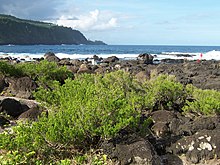- Mentigi bushes behind a dry grass field in Europa Island.
- Mentigi branches
| Pemphis acidula | |
|---|---|
 | |
| Pemphis acidula bushes on the shore of Réunion Island | |
| Scientific classification | |
| Kingdom: | Plantae |
| Clade: | Tracheophytes |
| Clade: | Angiosperms |
| Clade: | Eudicots |
| Clade: | Rosids |
| Order: | Myrtales |
| Family: | Lythraceae |
| Genus: | Pemphis |
| Species: | P. acidula |
| Binomial name | |
| Pemphis acidula | |
| Synonyms [2] | |
Pemphis acidula, commonly known as bantigue (pron. bahn-TEE-geh) or mentigi, [3] [4] [5] is a species of flowering plant in the family Lythraceae. It is the only species in the genus Pemphis . [6]
Contents
It is found growing in sandy and calcareous soils in littoral zones, rocky shores and mangroves throughout most of the tropical Indo-Pacific. [7] [5]





